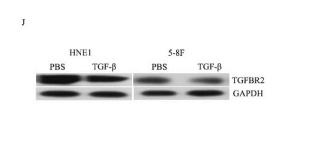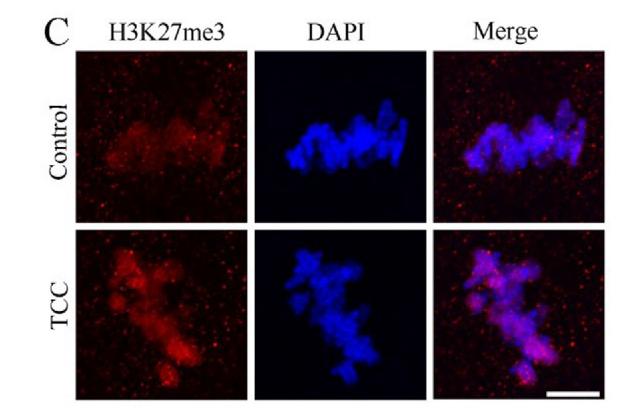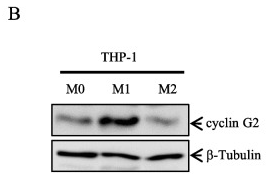CCNG2 Antibody - #DF2284
| Product: | CCNG2 Antibody |
| Catalog: | DF2284 |
| Description: | Rabbit polyclonal antibody to CCNG2 |
| Application: | WB IF/ICC |
| Cited expt.: | WB, IF/ICC |
| Reactivity: | Human, Mouse |
| Prediction: | Bovine, Horse, Sheep, Rabbit, Dog, Chicken |
| Mol.Wt.: | 39 kD; 39kD(Calculated). |
| Uniprot: | Q16589 |
| RRID: | AB_2839511 |
Related Downloads
Protocols
Product Info
*The optimal dilutions should be determined by the end user.
*Tips:
WB: For western blot detection of denatured protein samples. IHC: For immunohistochemical detection of paraffin sections (IHC-p) or frozen sections (IHC-f) of tissue samples. IF/ICC: For immunofluorescence detection of cell samples. ELISA(peptide): For ELISA detection of antigenic peptide.
Cite Format: Affinity Biosciences Cat# DF2284, RRID:AB_2839511.
Fold/Unfold
CCNG 2; Ccng2; CCNG2 protein; CCNG2_HUMAN; Cyclin-G2; CyclinG2;
Immunogens
A synthesized peptide derived from human CCNG2, corresponding to a region within C-terminal amino acids.
High levels in cerebellum, thymus, spleen and prostate. Low levels in skeletal muscle.
- Q16589 CCNG2_HUMAN:
- Protein BLAST With
- NCBI/
- ExPASy/
- Uniprot
MKDLGAEHLAGHEGVQLLGLLNVYLEQEERFQPREKGLSLIEATPENDNTLCPGLRNAKVEDLRSLANFFGSCTETFVLAVNILDRFLALMKVKPKHLSCIGVCSFLLAARIVEEDCNIPSTHDVIRISQCKCTASDIKRMEKIISEKLHYELEATTALNFLHLYHTIILCHTSERKEILSLDKLEAQLKACNCRLIFSKAKPSVLALCLLNLEVETLKSVELLEILLLVKKHSKINDTEFFYWRELVSKCLAEYSSPECCKPDLKKLVWIVSRRTAQNLHNSYYSVPELPTIPEGGCFDESESEDSCEDMSCGEESLSSSPPSDQECTFFFNFKVAQTLCFPS
Predictions
Score>80(red) has high confidence and is suggested to be used for WB detection. *The prediction model is mainly based on the alignment of immunogen sequences, the results are for reference only, not as the basis of quality assurance.
High(score>80) Medium(80>score>50) Low(score<50) No confidence
Research Backgrounds
May play a role in growth regulation and in negative regulation of cell cycle progression.
Cytoplasm.
High levels in cerebellum, thymus, spleen and prostate. Low levels in skeletal muscle.
Belongs to the cyclin family. Cyclin G subfamily.
Research Fields
· Cellular Processes > Cell growth and death > p53 signaling pathway. (View pathway)
· Environmental Information Processing > Signal transduction > FoxO signaling pathway. (View pathway)
References
Application: WB Species: human Sample: Gastric cancer cells
Application: WB Species: human Sample: three gastric cell lines and human normal gastric epithelial cell
Application: IHC Species: human Sample: SGC-7901 or MGC-803 gastric cancer cells
Application: IF/ICC Species: monkey Sample: COS-7 cells
Application: IHC Species: Mouse Sample:
Restrictive clause
Affinity Biosciences tests all products strictly. Citations are provided as a resource for additional applications that have not been validated by Affinity Biosciences. Please choose the appropriate format for each application and consult Materials and Methods sections for additional details about the use of any product in these publications.
For Research Use Only.
Not for use in diagnostic or therapeutic procedures. Not for resale. Not for distribution without written consent. Affinity Biosciences will not be held responsible for patent infringement or other violations that may occur with the use of our products. Affinity Biosciences, Affinity Biosciences Logo and all other trademarks are the property of Affinity Biosciences LTD.





